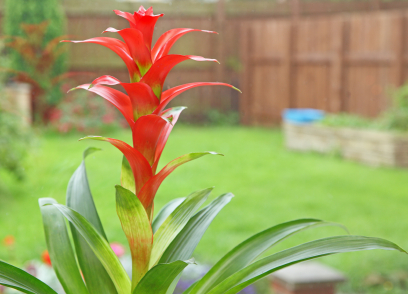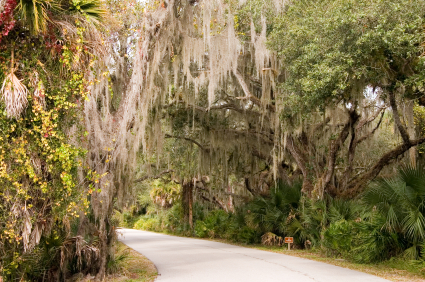Looking for a Challenge? Check out these 5 Bromeliads
Author: Melanie Dearringer1 Comment
Many bromeliads are very easy to grow. Their natural adaptations lend themselves well to indoor environments. Most require a little water, bright indirect light, and moderate temperatures. Some will do well in low light conditions and they often recover quickly from neglect. While many bromeliads a great for beginner growers and a variety of household situations, others require a bit more attention and care.
If you have been growing bromeliads for a while and are ready to try something new, there are several varieties that will make beautiful and unique additions to your collection. These varieties may be a little more difficult to find and require a bit more specialized care, but are very rewarding. Here are five of the more challenging, yet worthwhile varieties of bromeliad to grow.
1. Vriesea corcovadensis
This species is named for Corcavado, the mountain that houses the Cristo Redentor statue in Rio De Janeiro. This mountain is typical of where Vriesea corcovado is found in nature.
Members of the Vriesea genus in general can be difficult to care for because they are more sensitive to humidity, and air circulation. Their soft foliage can be prone to root rot if the proper balance of humidity and air movement is not maintained.
Vriesea corcovadensis has long soft dark green leaves that grow in a rosette form. It grows up to ten inches tall and eight inches wide. The plant produces a tall spike that rises above the flower. The inflorescence is a reddish pink with a small light yellow tube shaped flower.
This plant can be planted terrestrially in a pot or mounted on a substrate. If mounted, wrap the roots in sphagnum moss and attach it to a substrate. This plant likes plenty of warmth and a lot of bright light. It should be generally kept moist with water in the rosette. Be sure to rinse out the rosette regularly to prevent mineral build up and disease or fungal growth. Watering with rain water or distilled water will also help prevent mineral build up on the sensitive leaves.
Vriesea corcovadensis is rarely seen in nature and endemic to a small area in Brazil. It is unique and fun to grow. This plant can be purchased from online from speciality bromeliad retailers.
2. Guzmania hollinensis

-A bromeliad from the Guzmania family.
Many Guzmania are commonly sold in nurseries, garden shops and even grocery stores. Guzmania hollinensis however is very rare. It has been placed on the International Union for Conservation of Nature (IUCN) Red List of threatened species. It is native to the Amazonian forest and low portions of the Andes in Ecuador. It is steadily being lost in nature as a result of deforestation.
This species is also rare in cultivation. It is very large in size and should be grown outdoors in a warm climate or in a large green house space. The foliage of the plant can reach 48 inches tall and 36 inches wide. It will produce a flower stalk up to nine feet tall. The foliage is a shiny, deep green that stands upright. It has prominent ridges running the length of the leaves. The inflorescence is greenish gray with gray-purple flowers that emerge close to the stalk.
Other than its size, Guzmania hollinensis is not incredibly showy, but its rarity makes it a worthwhile to add to a collection. If you have plenty of space and patience to care for this large growing plant, consider investing in this disappearing species.
3. Canistrum lanigerum
Canistrum lanigerum is one of only fifteen species in the Canistrum genus. It is native to the Bahia region of Brazil. It is a wide, low growing plant that is a foot tall and up to thirty inches wide. It has light green leaves that are rounded at the ends and grow slightly more narrow as they reach the center of the plant. The also have small spines around the margin of the plant. The small, numerous, pinkish flowers are nestled in the center cup of the plant. When flowering the leaves blush a bright red toward the center of the plant.
Unlike many bromeliads, this plant produce flowers in the fall and winter rather than summer. The plant requires moderate indirect light and a warm environment. This plant should not remain soggy to avoid root rot. Plant it in a well draining mix and allow the potting mix to dry a bit between waterings. Remember, for most bromeliads it is easier to recover from having too little water than too much.
4. Tillandsia albertiana

-Spanish Moss is part of the Tillandsia family.
Tillandsias are also known as air plants because they typically grow attached to a substrate. Tillandsia albertiana is a small bromeliad, growing between two and six inches tall. It has silvery green, narrow, cylindrical leaves. It produces a bright red, attractive flower with three petals. This plant will quickly form large sphere shaped clumps. Each plant only produces one flower, but with many plants forming a large clump there will be plenty of flowers to enjoy.
Like all Tillandsias this species uses its silvery scales, called trichomes, to draw its moisture from the air. It should be kept in a humid location or misted regularly to keep it from drying out. It also requires plenty of good air circulation so that it does not rot. In addition the plant needs a lot of bright light to thrive.
If you have not grown Tillandsias before, Tillandsia albertiana is a great way to expand your bromeliad growing knowledge. It will reward your effort with large, healthy clumps and numerous attractive flowers.
5. Puya laxa
Puyas are often incredibly large, very slow growing and covered in very sharp spines. These characteristics make them less desirable for a bromeliad collection. Puya laxa, however, is a sparsely foliaged pant that will only grow up to two feet across. The leaves are edged with sharp spines and covered in hairy silvery trichomes. The plant produces a long branched inflorescence with small, purple, tubular flowers.
The Puya laxa should be planted in a well draining container or terrestrially in a climate permitting outdoor landscape. The plant prefers full sun, but it will tolerate some shade as well. This plant is a great way to add a Puya to your bromeliad collection when you don’t have space for the larger Puya varieties.
Worth The Effort
These five plants can be rare to find and require a bit more attention than other bromeliads. However, they are a fun challenge to a bromeliad collector. If you are an enthusiast, consider investing the money, time and attention into growing these rewarding and unique plants. Challenging bromeliads are worth all of the effort and you will enjoy watching your well cared for plant thrive. What bromeliad species have challenged you as a grower?
Sources
“Vriesea corcovadensis.” Tropiflora <http://www.tropiflora.com/shop.cfm?page=display&ProductID=55899&CategoryID=46&letter=v&iPageNbr=1&src=alpha>
“Vriesea corcovadensis.” Hortipedia. <http://en.hortipedia.com/wiki/Vriesea_corcovadensis>
“Guzmania hollinensis” The IUCN Red list of Threatened Species. <http://www.iucnredlist.org/details/43252/0>
“Guzmania hollinensis” Tropiflora. <http://www.tropiflora.com/shop.cfm?page=display&ProductID=50221&CategoryID=46&letter=g&iPageNbr=1&src=alpha>
“Canistrum lanigerum” Tropiflora. <http://www.tropiflora.com/shop.cfm?page=display&ProductID=50378&CategoryID=46&letter=c&iPageNbr=1&src=alpha>
“Tillandsia albertiana” Plant Oddities. <http://plantoddities.com/cgi-bin/p/awtp-product.cgi?d=plant-oddities&item=1768>
“Tillandsia albertiana” Tropiflora. <http://www.tropiflora.com/shop.cfm?page=display&ProductID=55001&CategoryID=46&letter=t&iPageNbr=4&src=alpha>
“Puya laxa” Topiflora, <http://www.tropiflora.com/shop.cfm?page=display&ProductID=54426&CategoryID=46&letter=p&iPageNbr=2&src=alpha>
One response on “Looking for a Challenge? Check out these 5 Bromeliads”
Leave a Reply

Resource Download
Hechtia Care Cheat Sheet
Learn how to care for your Hechtia bromeliad with this quick and easy informational guide.
Learn More
Ask an Expert
Questions about bromeliads?
Our experts love a challenge!
Photo of the Week
Submit your photo to be featured on the blog!
More Photo of the Week Winners
Submit Photo








Once the flower (red) part of the plant begins to turn brown and dry, should I cut off the flowering part?